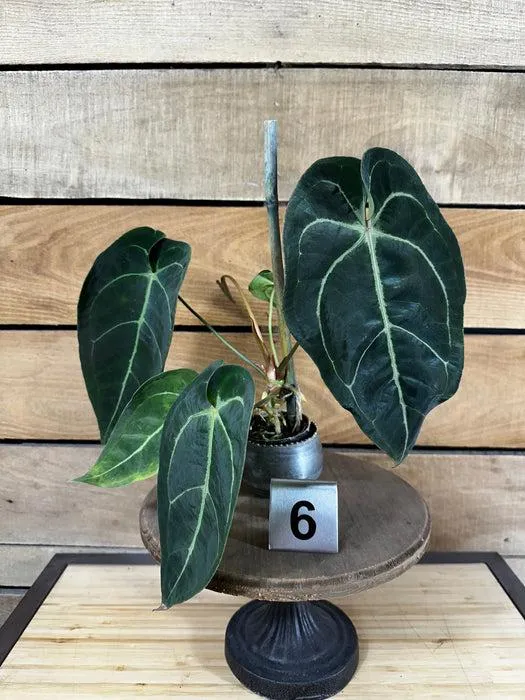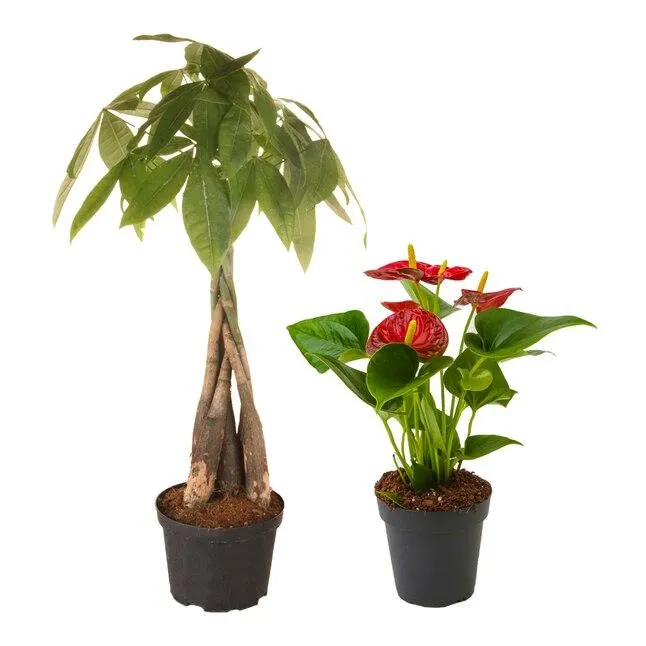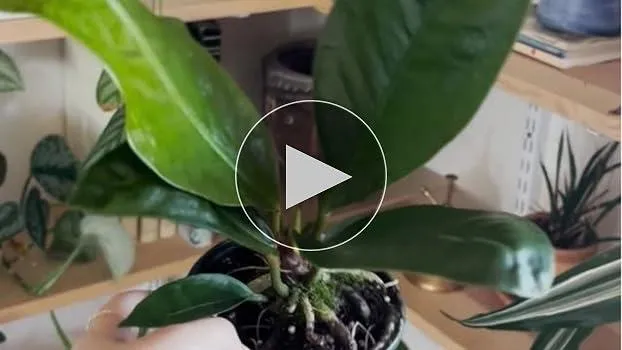Anthurium vs Alocasia: Comparing Two Popular Houseplants
Whether you’re a seasoned plant parent or just getting started in the houseplant world, chances are you’ve come across anthurium and alocasia plants. These tropical beauties are commonly found in home and garden centers for their lush foliage and low-maintenance care. But how do you know which one is best for your space? Let’s break down the key differences between anthurium and alocasia.
Origin and Appearance
- Anthurium: Native to tropical regions of Central and South America, anthuriums are known for their heart-shaped leaves and colorful, waxy flowers that resemble heart shapes. The leaves come in various colors from deep green to burgundy shades. When well cared for, an anthurium can produce flowers year-round that last for weeks at a time.
- Alocasia: Hailing from Southeast Asia and parts of Africa, alocasias have dramatic, broad arrow- or spear-shaped leaves. The leaves come in many dazzling shades like deep greens, silvers, and variegated patterns. Unlike anthuriums, alocasias are strictly foliage plants that don’t bloom. But their foliage alone makes a striking design statement.
From my experience, anthuriums have a certain elegance to their heart-shaped leaves and flowers. But alocasias basically steal the show with their truly unique leaf shapes and styles. They’re like no other plant, you know?
Care Requirements
On the care front, anthuriums tend to be a bit more low-maintenance than alocasias. Both love humidity, but alocasias are kind of finicky and demand consistently moist soil. Here are some key care points for each:
Anthurium
– Water when top 1-2 inches of soil are dry
– Medium to low light. Avoid direct sun
– Fertilize monthly in spring/summer
– Tolerates dry air better than alocasias
Alocasia
– Keep soil constantly moist, but not soaked
– Prefers humidity above 50%. Use pebble trays or humidifier
– Avoid direct sun. Filtered light best
– May drop leaves if soil dries out too much
– Can be prone to pests/diseases in dry air
So in summary – anthuriums are pretty low-effort while alocasias demand an almost green thumb. They look awesome but man, you really gotta stay on top of the moisture levels! Still, their weird leaf shapes totally make it worth it IMO.
Size and Placement
When it comes to size and placement, anthuriums and alocasias have some key differences:
Mature Height:
– Anthurium: 1-3 feet tall
– Alocasia: 2-5 feet tall

Ideal Placement:
– Anthurium: Great for desks, shelves, or as accents on tables. Compact size is versatile.
– Alocasia: Needs more room to spread out their broad leaves. Best alongside walls, in large pots on floors, or as tabletop accents.
So anthuriums give you more placement options due to their compact size. Meanwhile alocasias make a bigger statement but require more floor space. Gotta watch out for those giant Amazonian leaves, amirite? Didn’t see it coming until WHAM!
Low Light Versatility
When it comes to adaptation to low light conditions, anthuriums have a leg up on alocasias:
– Anthuriums tolerate low indirect daylight very well and can even survive in notoriously low light office areas for weeks at a time. Their waxy leaves and heart shapes help them hold onto moisture.
– Alocasias want more consistent medium to bright, indirect light. While they’ll survive for a bit in lower light, they may drop older leaf pairs more quickly until moved to brighter placement. Too low and leggy growth can occur.
So for apartments or offices with limited light, anthuriums will give you less stress. Alocasias need a little TLC with proper lighting needs. Overall I’d say anthuriums win in the low light versatility category – they’re sorta like the rugged plants, ya know?
Propagation and Division
When it comes to growing more plant babies, both anthurium and alocasia can be propagated in a few different ways:
– Anthuriums: Take stem cuttings, pups from the mother plant, or grow from seeds. They root very easily in water or soil.
– Alocasias: Divide mature corms or rhizomes to grow more plants. You can also start from cormels – miniature corms that form on the mother plant.

Basically they both spread quickly if conditions are right. One big difference is anthuriums coming through with seeds too. But man, peeling those weird alocasia bulbs apart feels kinda wrong, lolol. I don’t think they like it, but more babies!
Overall, while both are very propagate-able, personal opinion is that anthuriums have an edge in easy of rooting leaf cuttings vs disturbing the precious alocasia bulbs and rhizomes. But you do you, plant parent! All part of the fun.
Pest and Disease Resistance
In the battle against pests and diseases, anthuriums generally have the upper hand:
– Anthuriums are low maintenance plants and not overly prone to issues when grown in favorable conditions. Occasional pests/mealybugs are about all you’d see.
– Alocasias require more specific care and can be susceptible to issues like scale, aphids, and fungal/bacterial diseases if overwatered regularly in low humidity.
So anthuriums win the pest/disease resistance category hands down. Of course location matters too – my friend in Florida said humidity is key for avoiding alocasia drama down there. So it evens the playing field in moist climates. Still, anthuriums seem like the more hardy and resilient choice overall based on my experience.
Overall Winner?
So in summary, while both anthurium and alocasia make gorgeous houseplants, when considering all the criteria of care needs, size versatility, growth habits, and resilience – anthuriums might just have the edge overall as the low-maintenance choice.
Their dramatic waxy flowers, numerous shapes and colors, ease of care, adaptability, and resistance to pests make them a great fit for most home and office settings. Plus they’re not as large growing as alocasias so more placement options.

That said, alocasias bring such unique beauty with their arrowhead foliage that could wow any space. With proper light, humidity, and moisture – they thrive magnificently. So for plant aficionados seeking a real challenge, alocasias are an awesome option.
In the end, both deserve a spot in any collection. So why not go for one of each and enjoy their differences? Variety is the spice of plant life after all. One plant couldn’t possibly meet every need.
Hope this breakdown has helped compare and contrast anthurium vs alocasia to best decide which might suit your space and plant parenting style. Let me know if any other questions come up! Always happy to chat houseplants.
Anthurium vs Alocasia Comparison Table
| Plant | Care Level | Blooms | Leaves | Toxicity |
|---|---|---|---|---|
| Anthurium | Moderate | Heart shaped blooms | Glossy, waxy leaves in various shapes and colors | Non-toxic |
| Alocasia | Moderate | No blooms, foliage plant | Large, tropical shaped leaves with veins | Toxic to pets |
| Anthurium | Prefers humidity | Various colors | May be ruffled or wavy edged | |
| Alocasia | Tolerates low light | May be colorful or variegated | Sap can cause skin irritation | |
| Anthurium | Needs moist soil | Blooms year round | ||
| Alocasia | Allow soil to dry between waterings | Veins and patterns on leaves |
FAQ
-
What is the difference between an anthurium and an alocasia?
Basically, anthuriums and alocasias are two different types of plants. Anthuriums have heart-shaped leaves and spider-like flowers, while alocasias have large “elephant ear” leaves. So in short, they look totally different from each other.
-
Are anthuriums and alocasias easy to care for?
Kinda sort of – both plants need similar care but each have some special requirements. Anthuriums like humidity so a pebble tray helps, but they don’t like soggy soil. Alocasias want moist soil but not soggy either. As long as you water them enough and give ’em decent light, they’re not too difficult to keep happy. At the same time, overwatering can cause root rot issues so it’s a balancing act!
-
Which plant has larger leaves, an anthurium or an alocasia?
Obviously, the alocasia wins here – it’s famous for its enormous, almost heart-shaped leaves. An alocasia leaf can get over a foot wide, while anthurium leaves are usually only a few inches at most. Alocasia leaves also come in lots of cool colors like dark green, silvery, or pinkish veins. So if giant leaves are your thing, the alocasia is a no-brainer.
-
Can anthuriums and alocasias be grown outdoors?
Maybe – it depends on where you live. Both love warmth and humidity so a tropical or subtropical climate is ideal. An anthurium might make it outdoors year-round in zones 9-11, but an alocasia is generally considered a houseplant. Nevertheless, you might try growing them outdoors in the summer on a patio or deck if you live in a warmer zone. Just don’t freak if the first frost kills them – they’ll grow back indoors next year!
-
Which plant flowers more reliably, an anthurium or an alocasia?
Oh man, I’d say an anthurium for sure. Alocasias are strictly foliage plants – they don’t bloom. Anthuriums, on the other hand, flower almost constantly depending on conditions. Their heart-shaped blooms come in colors from red to orangey-pink. So if flowers are your thing then an anthurium totally wins hands down, no questions asked! The incredible blooms are definitely worth growing them for.

So in summary, while anthuriums and alocasias might seem similar, they’ve got some pretty major differences too – like leaf shape and flower production. They’re both awesome plants but each has its own strengths. Let me know if you need any other plant info – I sorta love talking about this stuff!
